Abuse among the elderly has perpetually been a growing concern. Elder abuse received the least amount of recognition and attention as of the beginning of the 20s. Even though by the 21st century we were quite aware of the other forms of prevalent abuses in domestic and institutional setup, elderly abuse has continued to remain unaccounted for and unreported for the very lack of its identification.
According to “The Older Population: 2010” Census briefs, about 13 percentage of the world’s population was age 65 and older, which is expected to encompass 19.3 percentage of the population by 2030. This means the elderly population is of considerable bulk and needs to be catered to in terms of their physical and mental health care along with their judicatory.
New research in this field is surfacing to enhance our understanding of elder abuse, its causes, characteristics, and preventive measures. New theories as to why people of older age suffer from psychological and physical neglect and abuse are being developed, to discourage the ill-treatment elder people have to face in domestic environments.
Due to the lack of systematic empirical data on this subject, the real causes of elder abuse are yet to be discovered. Unless and until a thorough understanding of the existence and prevalence of elder abuse is acquired, it will fail to instigate a social response. Researchers say that there is also an absence of a guiding theory as to why elder abuse happens.
Unlike other forms of abuse, like domestic violence, physical abuse, and psychological abuse, elder abuse has not gained enough notoriety to be considered an urgent social evil. Nevertheless, cases of elder abuse are being reported and its prevalence is gaining momentum.
Read 12 Signs You Are Being Emotionally Abused
What Is Elder Abuse?
It is of absolute necessity to have a well-structured definition of elder abuse to categorize actions as abusive or non-abusive. It helps determine the intensity of the abuse and take proper actions for it.
Elder abuse is often very vaguely defined or is defined for specific requirements say for research purposes or on a cultural, regional, and territorial basis, resulting in the absence of a generic definition that is accepted worldwide.
Sketching Elder Abuse
An elder person is someone who is of the chronological age of 65 years or above. Most developed countries of the world accept this age range as the standard age range to define ‘older people’. But the Older Americans Act Of 1965 defines an older person as “an individual who is 60 years of age or older.”
According to the American Medical Association (1997), elder abuse can be defined as, “An act or omission which results in harm or threatened harm to the health or welfare of an elderly person. Abuse includes the intentional infliction of physical or mental injury; sexual abuse; or withholding of necessary food, clothing, and medical care to meet the physical and mental needs of an elderly person by one having the care, custody, or responsibility of an elderly person.”
In simpler words, it is an action by a caregiver or any person with whom the elderly are associated in a relationship of trust that infringes on physical and psychological health, security of an elder person, with the means to harm them or omission of actions which involves providing, caring and meeting needs and taking responsibilities of an older person.
The perpetrator is the offender or the person in relation to the elderly person who inflicts harm or abuses the elderly person. Such a person must be someone on whom the elder person has willingly assumed obligation or is bound in a relationship of expected trust.
A perpetrator can be anyone – current or former legal spouse, caregiver(informal or formal), children, grandchildren, family relatives, other intimate partners with whom the elderly might or might not be co-habiting (former or current girlfriend/boyfriend/partners of the opposite or same-sex), care custodian, legal guardian, friend, casual acquaintances, anyone in a powerful position of trust or even a stranger.
Elder abuse can be both intentional and unintentional on the part of the perpetrator.
Intentional harm to elderly people is intended, planned, and willfully committed. Unintended harm can occur as a result of circumstantial factors, not in the volition of the perpetrator. Determining and defining intent is an indispensable prerequisite in administering effective intervention strategies. Though it is quite difficult to differentiate intentional harm from involuntary harm, distinguishing them is of utmost importance to address and prevent elder abuse.
This kind of abuse can occur in domestic as well as institutional setups. Each year over thousands of older adults gets abused. Younger children in the family witness this abuse and learn it from their parents and this can get passed on across generations. Therefore, it is necessary that adults in the family set better examples for their upcoming generations.
Read Understanding Abandonment Trauma and The Road To Recovery
How Can You Recognize Elder Abuse? 7 Types Of Elder Abuse
It is for you to note that the terminology can take different shapes depending on the kind of elder abuse in concern. They also vary in specificity, indicators, elements of the definition, and their behavioral manifestations.
Elder abuse can manifest itself in several forms. The other variations of terminology closely associated with elder abuse which you need to include in your understanding of the subject are as follows:
(Note: These are the different forms in which elder abuse manifests itself.)
1. Neglect
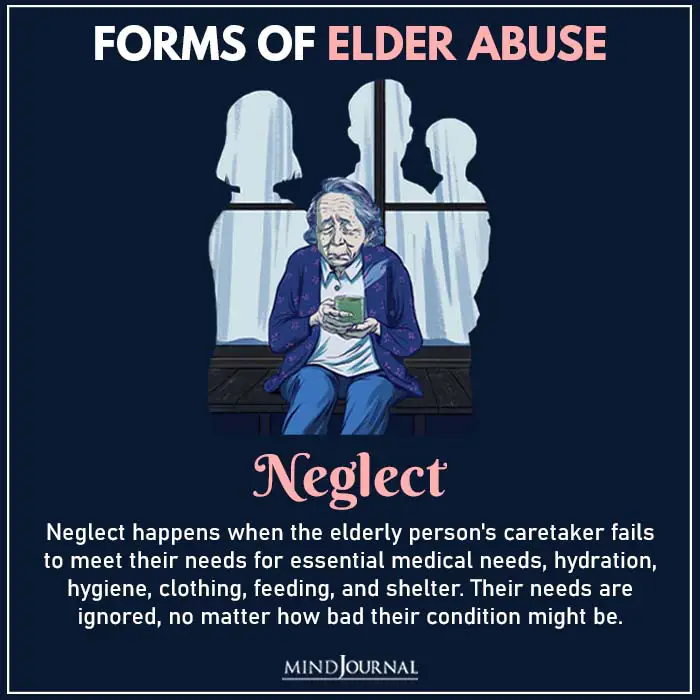
Senescent needs similar care as that of a child. They need to be protected, provided, and assisted in their daily activities, especially if they have any neurodegenerative disorders, physiological disorders, or require special caretaking.
According to a definition given by the Administration on Aging National Center on Elder Abuse, Neglect can be defined as, “The refusal or failure to fulfill any part of a person’s obligations or duties to an elder. Neglect may also include failure of a person who has fiduciary responsibilities to provide care for an elder (e.g., pay for necessary home care services) or the failure on the part of an in-home service provider to provide the necessary care.”
Neglect, in turn, can be of various degree and kind, some of which includes failure to meet the needs for essential medical needs, hydration, hygiene, clothing, feeding, and shelter.
Understanding neglect:
- Failure to meet essential medical requirements
Failure on the part of the caregiver or one who is associated in a trustworthy relationship with the elder person to provide him/her with medical facilities, dental care, seek regular medical check-ups, medicines, and other necessary medical assistance.
- Hydration
Failing to provide the elderly person with the necessary amount of fluid consumption or failing to assure that the elderly person is having adequate and sufficient water intake.
- Hygiene
Failing to provide or assure regular baths/showers; normal grooming practices like combing one’s hair, cutting one’s nails, taking care of one’s skin and teeth, proper disposal of bodily waste of any form (urine, feces), etc.
- Clothing
Failure to provide or assure adequate clothing suitable for the weather, clean, and aligned with the cultural and customary practices of that area.
- Feeding
Failure to provide and assure adequate, health-promoting nutritious food suitably cooked to make it easy for an elderly person’s consumption.
- Shelter
Failure to provide and assure a healthy living environment free of overcrowding with proper hygiene and structural facilities and also providing safety from these elements.
Read Abuse Doesn’t Always Leave Bruises And Broken Bones: Why The Inner Damage Is Worse
2. Psychological or emotional abuse
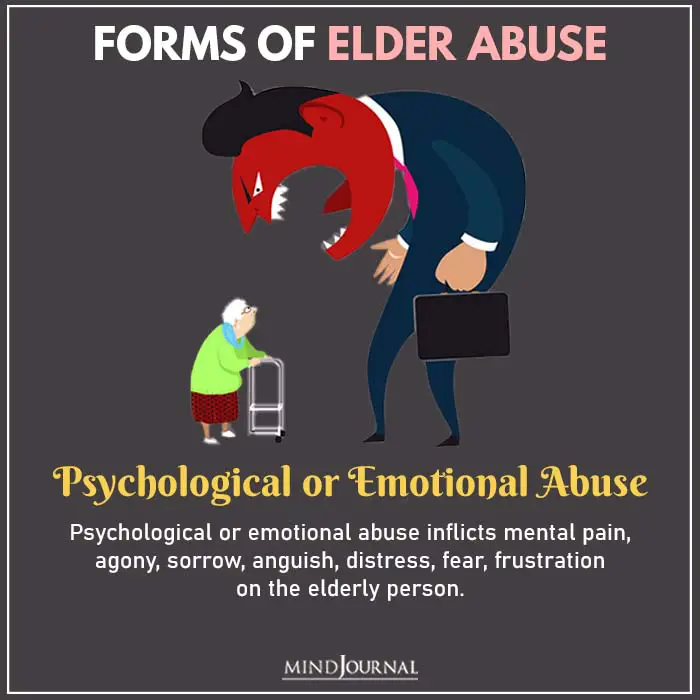
Any behavior, both non-verbal and verbal, on the part of the caregiver or any other person closely related to the elderly person in a relationship of trust, which inflicts mental pain, agony, sorrow, anguish, distress, fear, frustration can be defined as psychological abuse.
In either form, it will disturb the mental peace of the elderly person. Such abuse can have an immediate or delayed effect on the person, lasting for a short or long period of time, even if they are not apparently acknowledged by the victim.
This form of abuse manifests itself in the following ways:
- Disrespectful behavior
Behaviors that are unquestionably humiliating in nature are meant to disregard, insult, disrespect, and devalue, demean, defame an elderly person. This can be verbal insults, infantilizing comments, name-calling like publicly calling the older person foolish, stupid, mad, useless, etc.
- Harassment
Repeated behavior that is intentional and is perceived by the older person as coercive, manipulative, and hostile in nature. For example, forcing the older adult to perform actions against their will, to track, follow, and keep a watch, and to make sure that the victim has knowledge of it. Repeatedly making communications like sending letters and emails, making phone calls, which are clearly undesirable to the older person.
- Threats
Non-verbal or verbal suggestions of intended physical, psychological and sexual mistreatment or harm. Manipulating situations and changing the response of the older person by communicating wish to take harmful actions against the older person if he/she fails to comply.
Threatening to neglect and deny basic amenities, to abandon and never return, destroying prized possessions, to terminate provisions of care and institutionalization, to harm pets, friends, and other family members, with or without any weapon.
- Isolation
Verbal or non-verbal behavior leading to the territorial or interpersonal isolation of the older person. For example, keeping the elderly person in house confinement; restricting communication with the outer world; stonewalling; silent treatment; relocating the person and seclusion from friends, family members, partners, spouses, and other social contacts; withholding assistive devices like hearing aide, walker, wheel-chair, spectacles, etc.
All these actions are meant to isolate and limit the elderly person’s interaction with the outer world.
3. Physical abuse
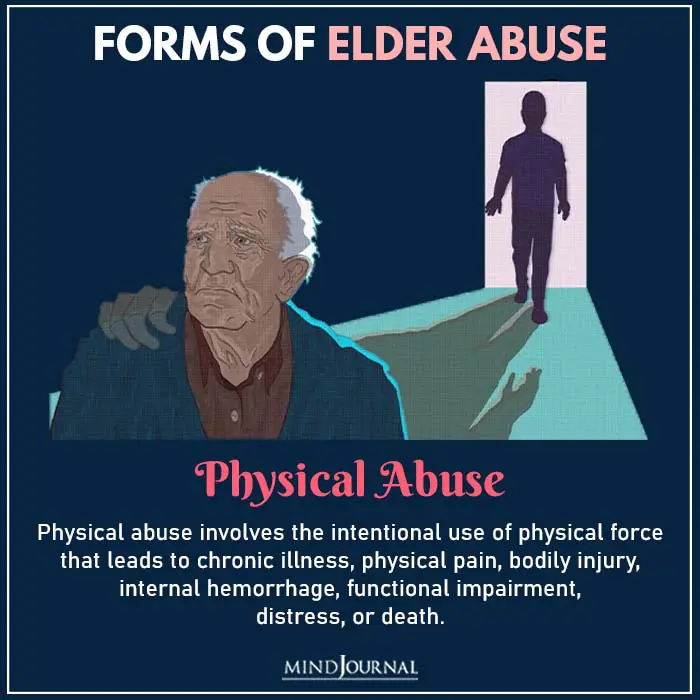
Physical abuse involves the intentional use of physical force that leads to chronic illness, physical pain, bodily injury, internal hemorrhage, functional impairment, distress, or death. It partially includes (alongside other forms) scratching, poking, beating, pulling, punching, kicking, hitting, biting, slapping, shaking, stomping, shoving, choking, pinching, and burning.
Other forms of physical abuse include inappropriate use of medicines, physical restraint, pinning in place, arm twisting, hair pulling, force-feeding, strangulating, etc.
Different manifestations of physical abuse:
- Inappropriate use of medications
This might lead to extreme distress, physical pain, bodily injury, functional impairment, or death. It involves the misuse of medication to take control over the elderly person at various degrees. Examples include but are not limited to over-administering prescribed drugs, especially over-sedation; administering non-prescribed or wrong drugs; under-medicating; medicating for purposes not intended to, etc.
- Use of physical restraints
Physical restraints refer to the inappropriate use of any device, material, or equipment that is attached to the elder’s body or is kept near the elder’s body to limit free bodily movement and wilful access to his/her body. Such restraints might be used as a punishment when the elderly person fails to comply with the perpetrator. It does not include medically authorized restraints of elderly people to manage violent behavior associated with chronic or acute psychiatric conditions.
- Physical punishment
Actions on the part of the perpetrator which inflicts direct or indirect physical pain and harm, which can lead to acute or chronic physical distress. Punishment is used for one of the following reasons:
1. To prevent behavior undesirable to the perpetrator.
2. To stop repetitive unwanted behavior.
3. On failing to perform a desired, required, or requested activity.
Read The Lifelong Effects of Childhood Neglect By Parents
4. Sexual abuse
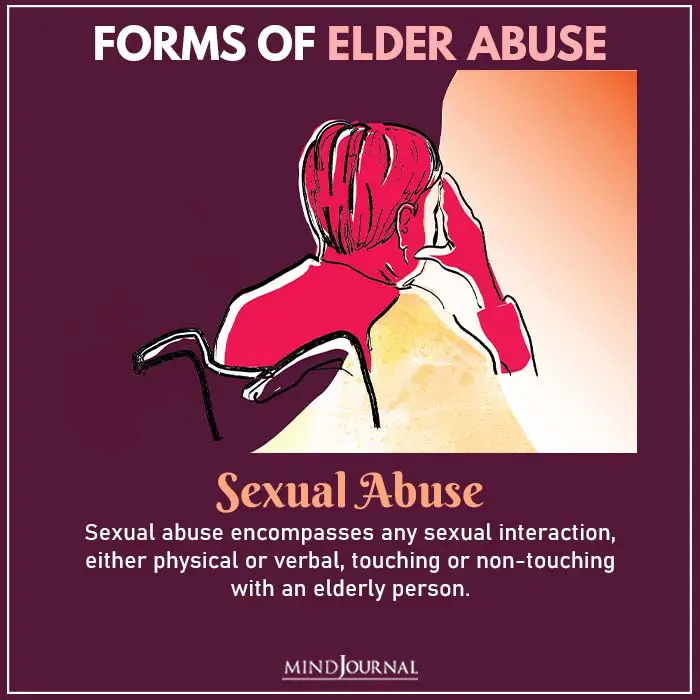
Sexual abuse encompasses any sexual interaction, either physical or verbal, touching or non-touching with an elderly person.
This includes but is not limited to:
- Forced or unwanted completed or attempted contact between the penis and the vulva or the penis and the anus, involving penetration, however slight.
- Forced or unwanted contact between the mouth and the pens, vulva or anus.
- Forced or unwanted penetration of anal or genital opening of the victim with any body parts of the perpetrator like finger, hand or other objects.
- Forced or unwanted yet intentional touching of the elder person’s body parts directly or through the clothing like genitalia, groin, breast, inner thighs, buttocks, anus etc.
- Forced or undesirable non-contact sexual acts like forcing the victim to watch pornographic materials through pictures or videos, recording sexual content by using the elder person for sexual gratifications.
- Voyeurism, by secretly watching an elderly person undressing or engaging in sexual activities to derive sexual pleasure.
- Sexual harassment through suggestions, advances, requests and threats. These can be both contact and non-contact acts.
5. Financial exploitation
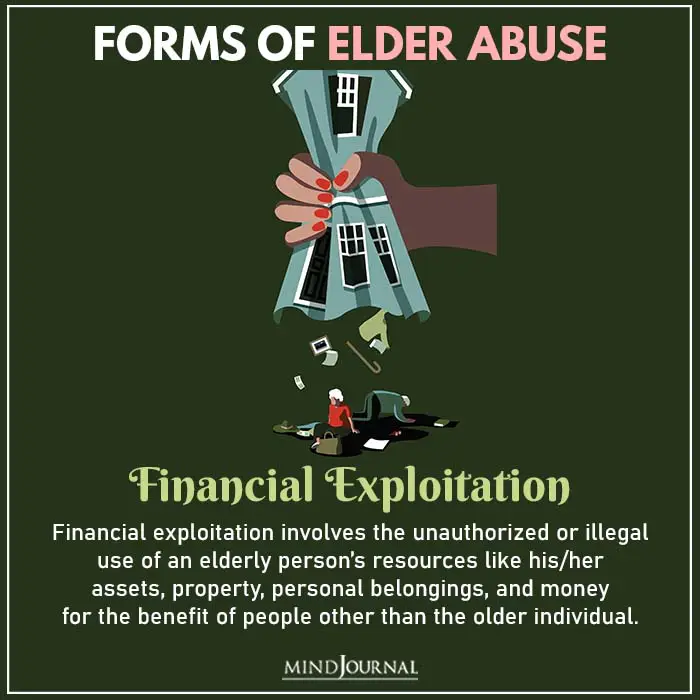
Financial exploitation involves the unauthorized or illegal use of an elderly person’s resources like his/her assets, property, personal belongings, and money for the benefit of people other than the older individual.
It also takes into consideration those actions which involve depriving the elderly individual of the rightful access to or information about his/her personal possessions or things of benefits.
Examples of such activities include:
- Selling or transferring property belonging to the individual against his/her choice.
- Taking money or items from the elderly’s account or house without his/her permission.
- Stealing the identity of the older adult to open accounts under his/her name to obtain services, rent, lease or buy properties.
- Forging his/her signature to withdraw money.
- Use of insurance to obtain medical facilities.
- Changing wills, trusts and altering inheritance arrangements without the older adult’s knowledge or against his/her wishes.
- Forcing the individual to sign documents without revealing its contents.
- Mishandling the older adult’s assets and preventing the older adult to access or control his own resources.
- Using the older adult’s credit or debit cards to make transactions.
- Abusing joint signature authority or bank account, etc.
It is important to mention that self-harm or self-neglect is a consistent construct according to the WHO (World Health Organisation) violence typology. Self-neglect is a form of self-abuse that might occur concurrently with elder abuse. It typically accompanies emotional abuse. Often the elder individuals find themselves in a hopeless situation when they have to undergo any form or degree of abuse.
Read Narcissist and Financial Abuse: How They Create a Monetary Hierarchy
6. Abandonment
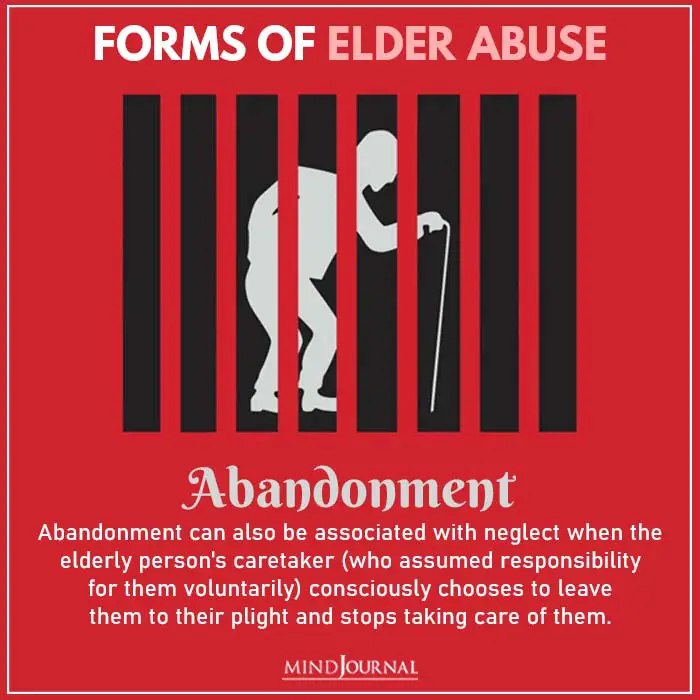
Abandonment can also be associated with neglect when the elderly person’s caretaker (who assumed responsibility for them voluntarily) consciously chooses to leave them to their plight and stops taking care of them. The caretaker might abandon the elderly person at the hospital, an old-age home, or in worst cases, even on the streets.
The elderly person is left helpless and forced to fend for themselves after they are abandoned.
These are signs that might show that an elderly person has been abandoned:
- Looks scared, depressed or lonely.
- Seems confused, lost, and anxious, and does not know what to do and how to take care of themselves.
- Poor standards of hygiene, such as horrible body odor, rotting teeth, physically weak etc.
- Looks to be dehydrated, hungry, malnourished, even starved.
7. Self-neglect
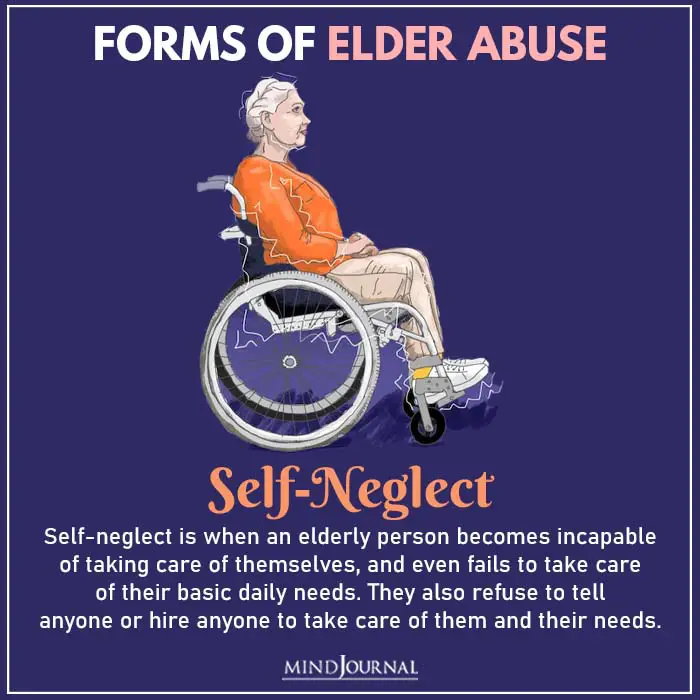
One of the saddest and probably the most overlooked type of elder abuse is self-neglect. Self-neglect is when an elderly person becomes incapable of taking care of themselves, and even fails to take care of their basic, daily needs; they also refuse to tell anyone or hire anyone to take care of them and their needs.
One of the major reasons behind self-neglect is that many old people tend to struggle with depending on someone else for their needs and health. They find it extremely hard to let go of that control and believe that they can indeed take care of themselves, without taking the help of some other person.
Self-neglect might hinder an elderly person’s capability to:
- Have proper, nutritious, and healthy food.
- Look after their basic hygiene needs.
- Manage their money matters.
- Taking care of their home and personal possessions.
- Dress well and properly.
- Taking care of their health, and other medical needs.
Signs of elderly self-neglect are:
- Scarcity of proper medical supplies.
- Filthy home and living environment.
- Filthy clothes.
- Absence of proper personal hygiene.
- Scarcity of food at home.
- Skin rashes and bedsores.
- Continous weight loss, and malnourishment.
- Neglected injuries and infections.
Standing Against Elder Abuse
There is often a sense of ‘apathy’ associated with elder abuse which makes it more difficult to identify and formulate preventive strategies. Ageism leads to a negative attitude towards older people which contributes to the absence of ‘moral panic’ regarding the mistreatment faced by older adults. (2)
Similarly, older adults often rationalize abuse by rendering it ‘normal’ and ‘common events in almost every household’ and silently suffer along. Elders often safeguard the perpetrator, especially if he/she is a close family member like children or spouse. Some adults are not even aware of the community and institutionally based help that they can seek if they face harassment or abuse even by family members.
Read 4 Steps To Have Hope In Hard Times
Preventive Measures For Elder Abuse
Like any other form of abuse, elder abuse is an equally important concern. If we want to eradicate it we must keep in mind that elder abuse can be intervened and prevented if we are aware and responsible enough to actively implement measures of precaution. Prevention of elder abuse is a necessity to promote life satisfaction and general health in the elder population so that they can live a fulfilling life and exercise their rights.
A few preventive measures to get help for an elderly person:
1. Increase understanding of elder abuse among elder members of the family. Explain thoroughly its causes, forms, degrees, manifestations, and how they can save themselves from being abused.
2. Teach elder members of the family self-care and self-help strategies as far as is feasible for them to perform. Performing comparatively easier activities like having one’s own medicine, keeping oneself hydrated, timely consumption of one’s own food, etc. will be of some help.
3. Understanding personal rights – the right to one’s assets, possession, and property, etc.
4. Learn and strengthen day-to-day problem-solving abilities like managing one’s own funds, insurance, cards, important documents, property and monitoring transactions, and limiting other people’s access to those resources.
5. Expand social networks and seek community help or take resort to self-help groups.
6. Be a part of elder associations or other community groups where you can meet like-minded people to share your experiences.
7. When in crisis, stay calm and abstain from arguing with the perpetrator.
8. If the perpetrator attacks with or without weapons, try to escape the situation and seek help from trusted neighbors.
9. Stay alert and pay attention to intuitive thoughts. If you notice something out of the place, immediately take action by seeking community help.
10. Keep trusted people’s contact numbers on speed dial. Dial the emergency number of your area if you need immediate help and in case of physical injury or wound.
11. If need be, shift to your relative’s house with identity documents, some cash and card, and required medications for a temporary stay.
12. Promoting public education and sensitizing younger adults about caring and respecting elderly people in domestic and public spaces.
13. Setting up campaigns and programs to train law enforcement officers, healthcare professionals, social activists, and social workers to recognize and respond to elder abuse.
14. Responsibilities of family members and caregivers:
- Openly communicate with the elderly person and do not keep unrealistic expectations from him/her.
- Do not hamper the older person’s mental peace by making the household environment toxic.
- Be patient and accepting of older individual’s feelings and provide him/her with emotional support.
- Optimise physical health by maintaining a nutritious diet and hygienic environment and helping elders engaging in self-care activities.
- Regulate the mood of older adults by encouraging them to involve in positive coping strategies like maintaining an appropriate level of physical activities, pursuing hobbies like listening to music, writing or reading.
- Provide proper training and supervision to monitor the well-being of elder individuals.
Elder abuse is a crime and needs to be fought against with equal fervor by the law enforcers and by all of us. With awareness and prompt action, elder abuse too can be stopped.
Read How My Journey Through Abuse Transformed My Life For The Better
More Information On Elder Abuse And Helplines
1. Eldercare Locator
1-800-677-1116 (toll-free)
eldercarelocator@n4a.org
https://eldercare.acl.gov/Public/Index.aspx
2. National Center on Elder Abuse
1-855-500-3537 (toll-free)
ncea-info@aoa.hhs.gov
https://ncea.acl.gov
3. National Adult Protective Services Association
1-217-523-4431
www.napsa-now.org
4. National Domestic Violence Hotline
1-800-799-7233 (toll-free, 24/7)
1-800-787-3224 (TTY/toll-free)
www.thehotline.org/get-help
5. U.S. Department of Justice
1-202-514-2000
1-800-877-8339 (TTY/toll-free)
elder.justice@usdoj.gov
www.justice.gov/elderjustice
References:
1. Werner, C.A., “The Older Population: 2010,” 2010 Census Briefs (C2010BR-09), Washington, D.C.: U.S. Census Bureau, November 2011, Retrieved April 10, 2013, from https://www.census.gov/prod/cen2010/ briefs/c2010br-09.pdf. 2. Nelson, T.D., “Ageism: Prejudice Against Our Feared Future Self,” Journal of Social Issues, 61 (2) (2005): 207–221; Penhale, B., and P. Kingston, “Social Perspectives on Elder Abuse, in Family Violence and the Caring Professions, eds., P. Kingston and B. Penhale, London: Macmillan, 1995: 222–244; Phelan, A., “Elder Abuse, Ageism, and Human Rights and Citizenship: Implications for Nursing Discourse,” Nursing Inquiry, 15 (4) (2008): 320–329.
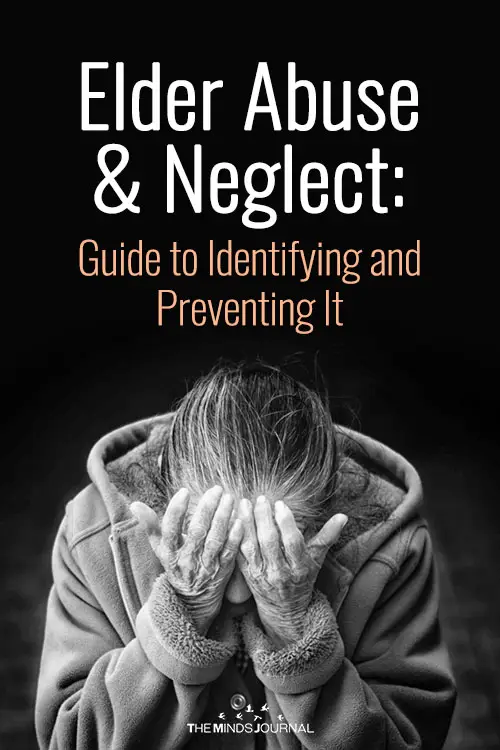
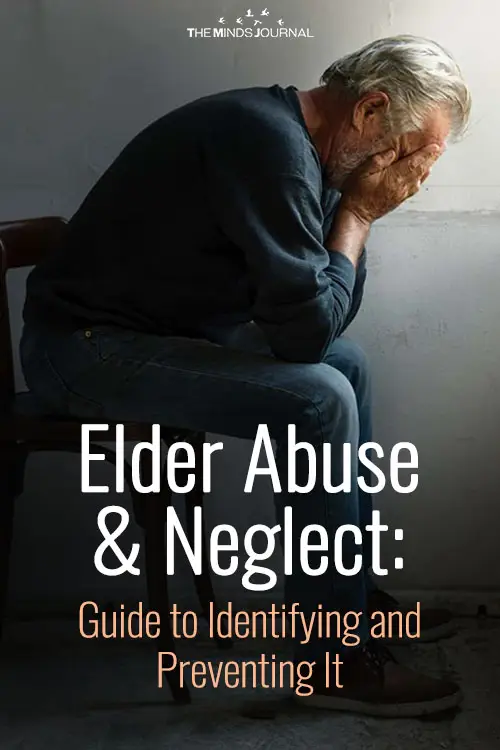
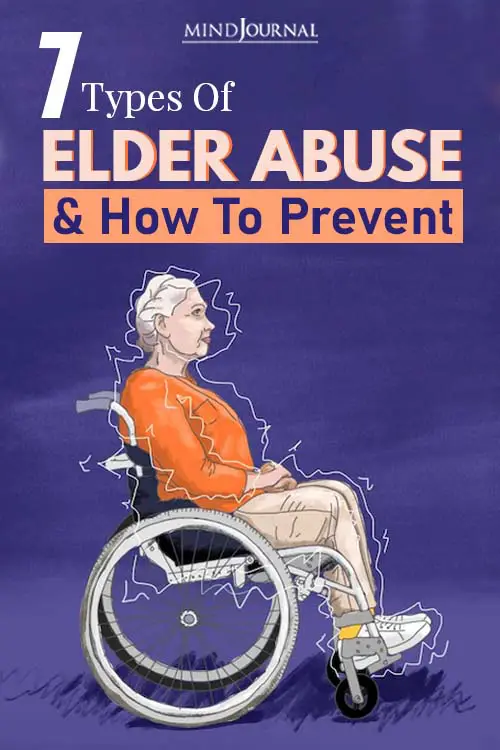
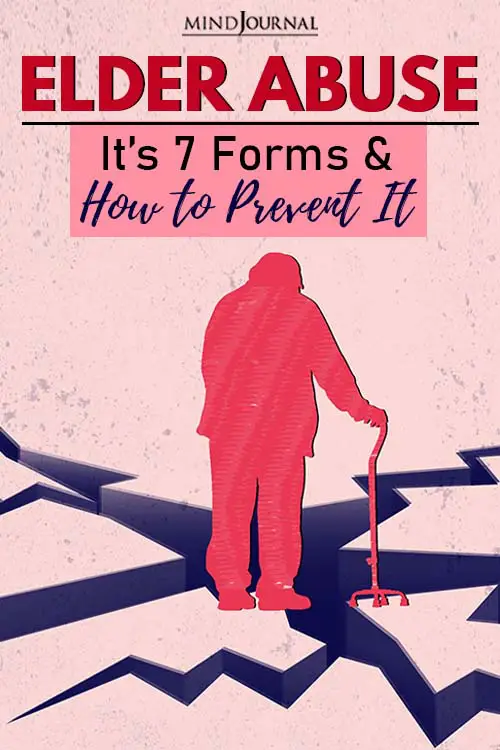
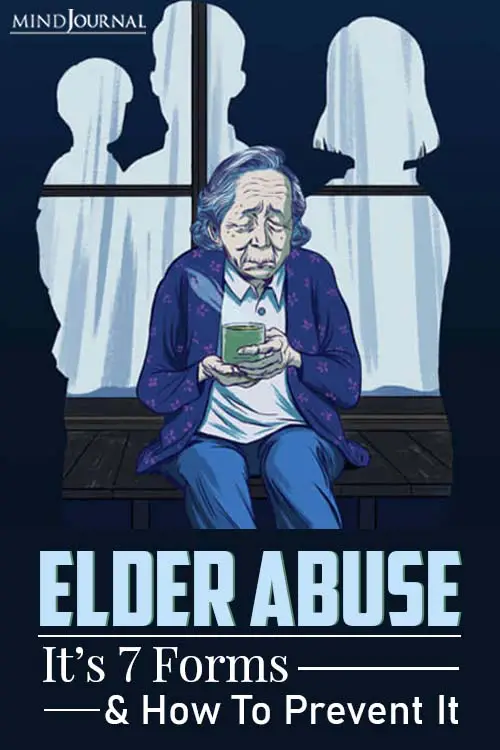
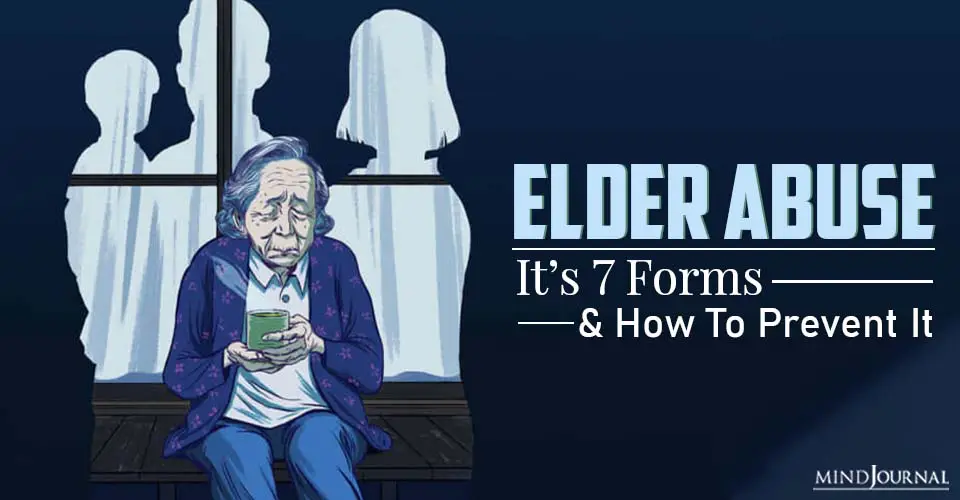
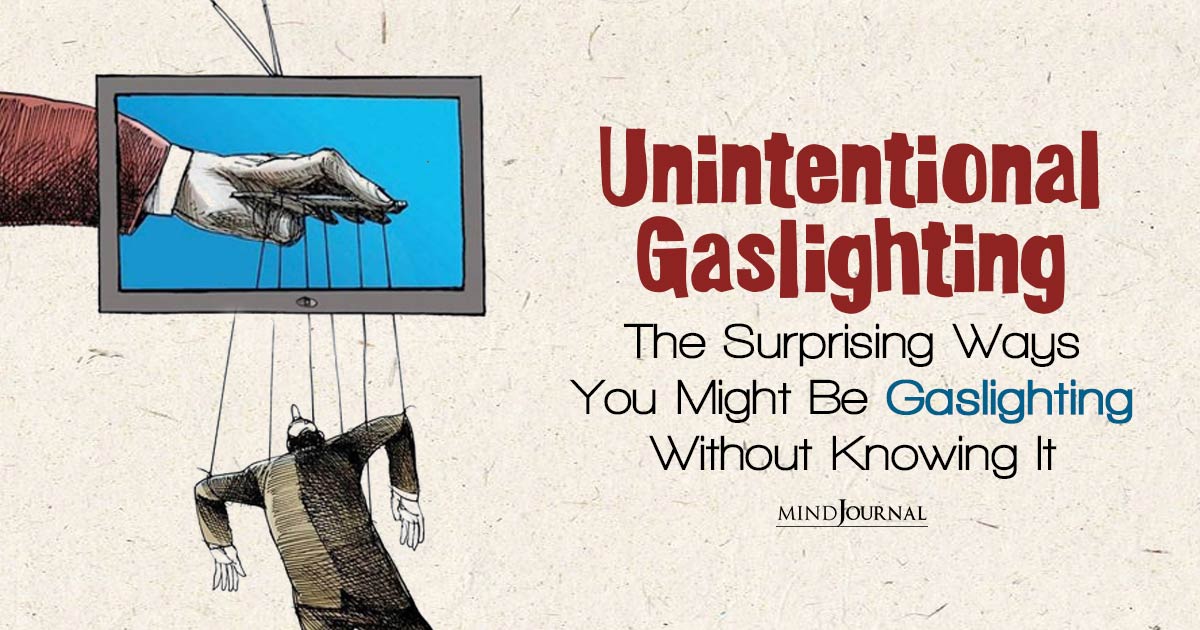


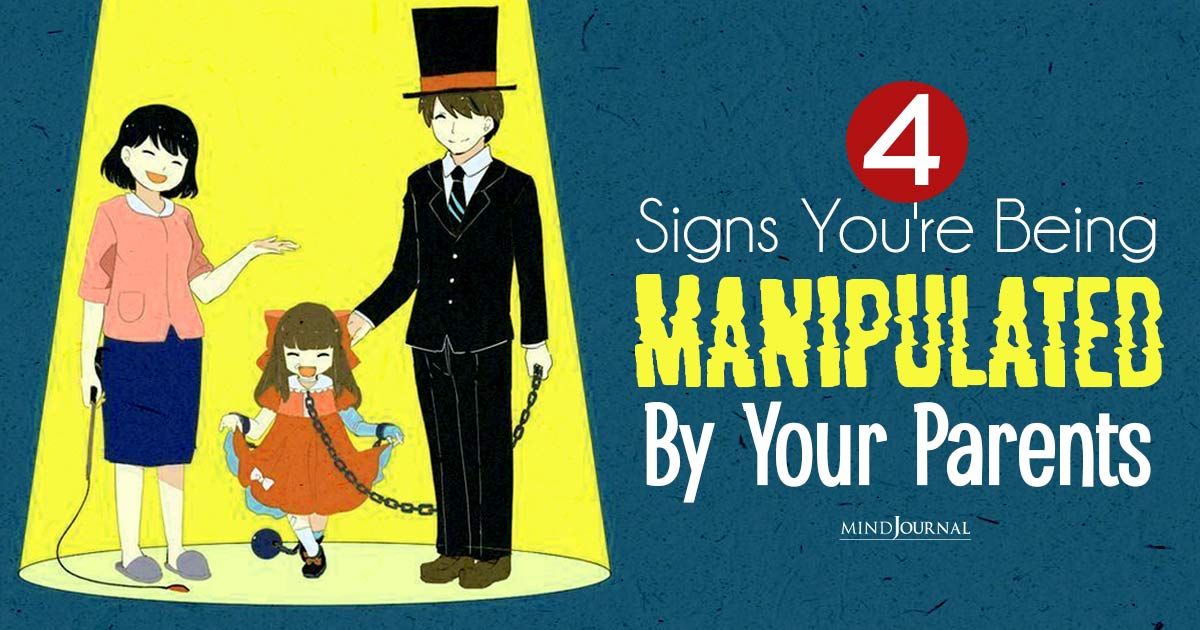
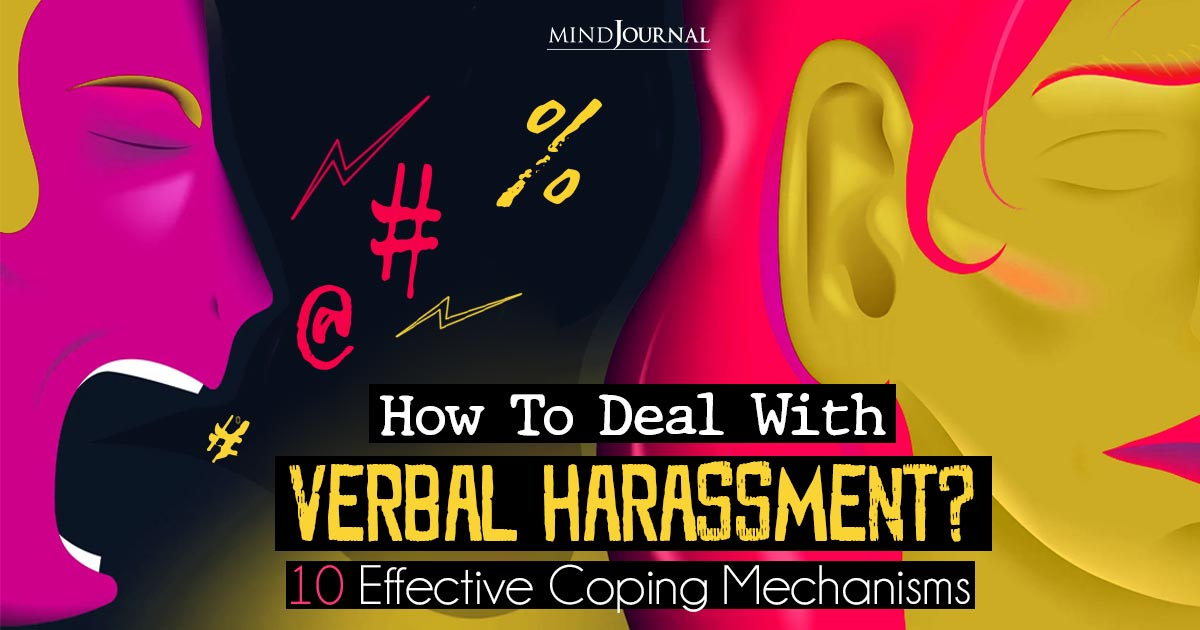

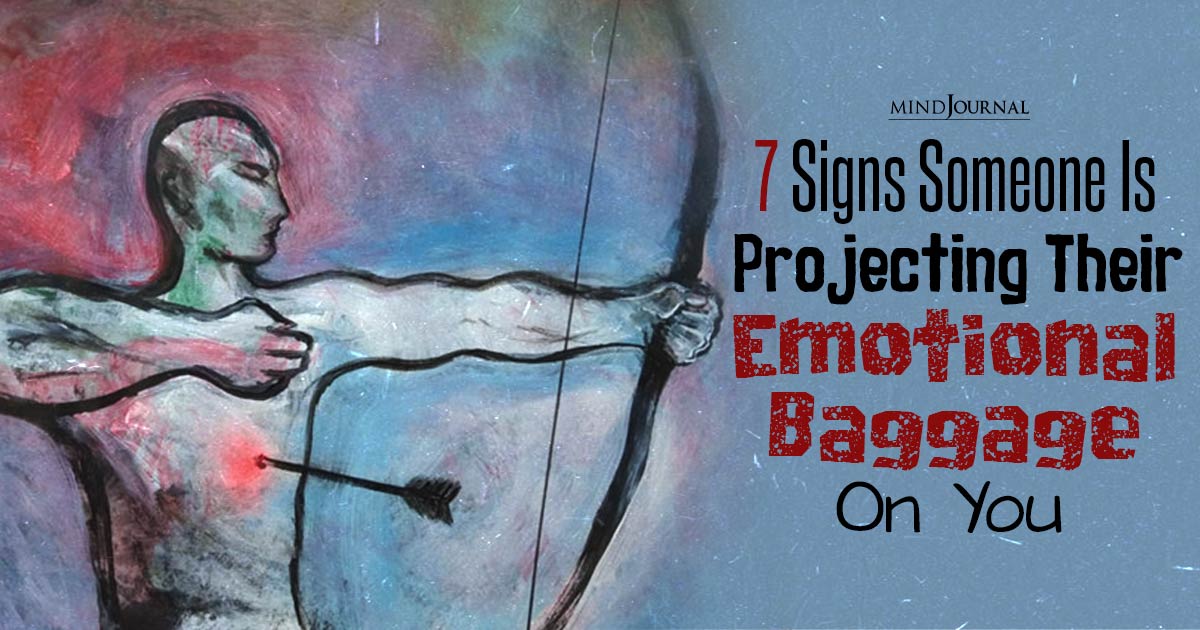
Leave a Reply
You must be logged in to post a comment.